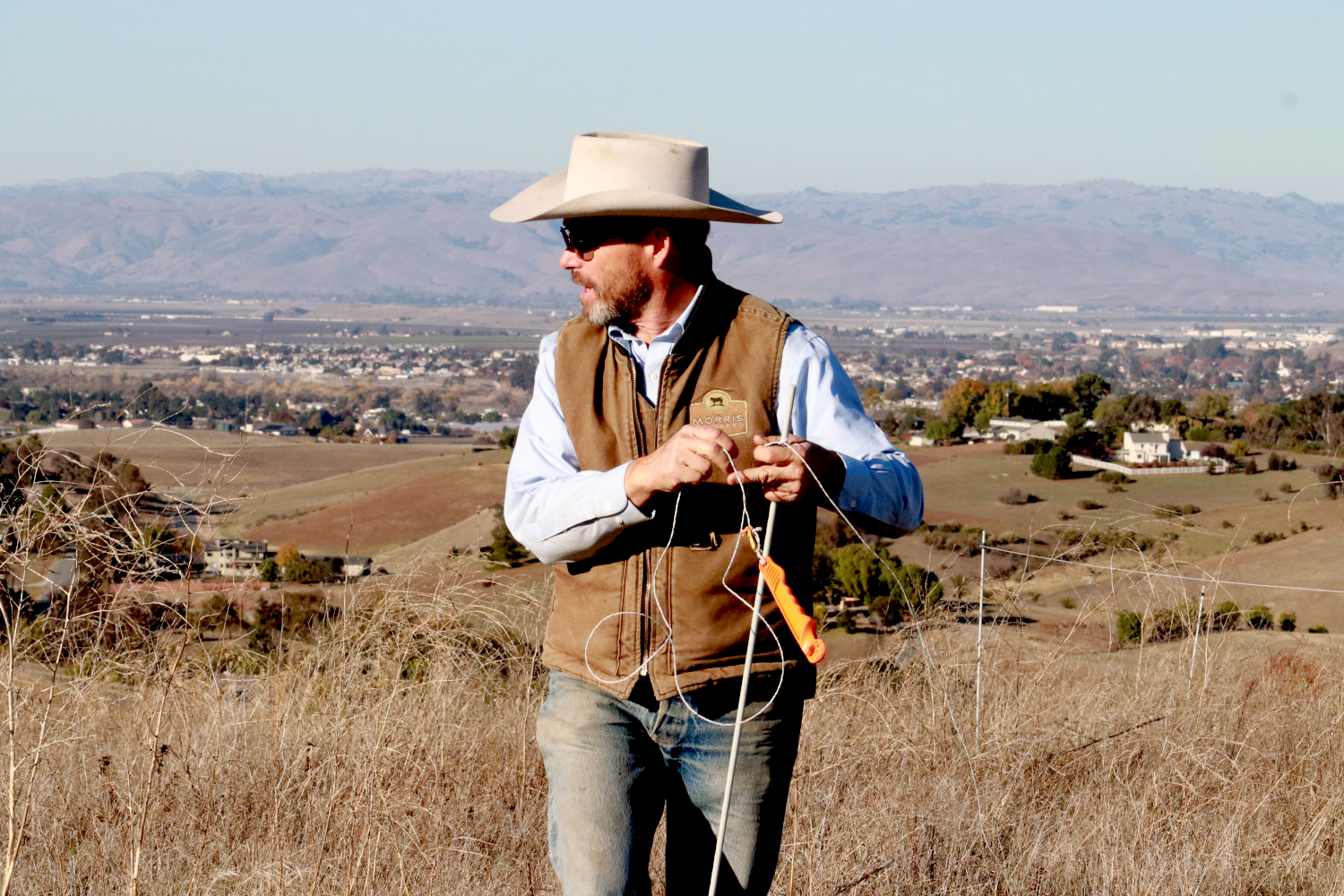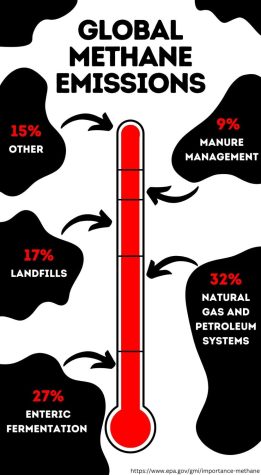
You can find her journalism portfolio here and her ceramics portfolio here.


Ranchers implement creative management techniques, striving for sustainability
February 7, 2023
Sustainability is a crucial focus for many California ranchers as they work to improve the ecosystems in their grasslands and the wellness of their cattle.
Ranching sustainably requires one to take a step back and look at the whole system. Ranchers must meet the needs of the ecosystem: soil, plants, cattle, and microorganisms.
“Sustainable ranching is ranching in a way that ensures that there’ll be future generations that can continue on in that behavior,” said Jeffrey Creque, the Director of Rangeland and Agroecosystem Management at the Carbon Cycle Institute (CCI).
27 billion pounds of beef are consumed by Americans every year. Several experts report that production takes a toll on the environment because of overgrazing, deforestation, and greenhouse gases. Some ranchers have put sustainability at the forefront of their concerns by introducing innovative management practices.
Methane is one of the most powerful greenhouse gasses involved in climate change. According to the Environmental Defense Fund, methane has 80 times the warming power of carbon dioxide over the first 20 years after it reaches the atmosphere. As seen in the chart to the right, ruminants, which include cattle, sheep, goats, and buffalo, are the second largest source of methane globally.

Ruminants undergo enteric fermentation as part of their digestive process. Cow belches and flatulence release methane into the atmosphere as a byproduct of enteric fermentation. A single cow produces 154 to 264 pounds of methane gas per year.
“Yes, cows emit methane. But the way sustainable ranching works is when you’re managing the cows to create a healthy landscape, the goal is also to be absorbing some of that methane, so it balances,” said Julie Morris.
Joe and Julie Morris are the owners of Morris Grassfed Beef, a ranch on the central coast of California dedicated to sustainability.
“Methane is not the problem. The methane can be a problem if it isn’t cycling or comes from a different source than the biological community,” Joe Morris said.
Historically, methane sinks and sources were balanced, so the methane cycled in a healthy pattern. Humans have created more methane sources, such as landfills, and destroyed methane sinks by neglecting the habitats of methanotrophs, microscopic methane-eating bacteria that live in healthy grasslands soil.
This has created an imbalance in the methane cycle, leading to methane getting trapped in the atmosphere.
Some ranchers have recognized the importance of their ranches in the methane cycle and are working to improve the strength of their ecosystems to benefit the methane cycle and the planet as a whole through innovative cattle and land management.
Some ranchers recognize the importance of soil health as one of the many factors in ensuring a ranch’s sustainability.
“When we’re using grazing animals, it’s as a tool to help provide nutrients to the soil,” said Wendy Millet, the Ranch Director at TomKat Ranch in Pescadero, Calif.
When the soil is not functioning correctly, the water cycle gets disrupted. The plants depend on water to survive; if the soil is not healthy, it will not absorb water for the plants.
“If you have healthy soil, it’ll catch all the water, but if you have compacted soil, for example, it could run off,” Millet said.
Soil health is essential in trapping enough water for plants to function. In turn, the water used and stored by plants cools the Earth.
“You could think of grass as sort of an ice pack. The grass is not only holding water, but it’s also attracting water and cooling that surface,” Julie Morris said.
Joe and Julie Morris measured more than 20 degrees Fahrenheit difference between a patch of ground with dense vegetation and one with scarce vegetation. These areas of bare ground heat the Earth’s surface, creating what Joe Morris refers to as a heat dome.
“A heat dome, because it’s bare ground, pushes water away, and it won’t rain,” Joe Morris said. “We’ve seen this all over the world in various places where the landscape is degraded, and it no longer rains as much as it used to.”
According to Joe Morris, it is essential to focus on the health of the land to prevent degradation and keep the environment healthy.
“Healthier soil will be full of microbes that provide nutrients to the plants and ultimately to the livestock,” Millet said.
Plants are the backbone of the entire ecosystem. According to Joe Morris, the traditional ranching knowledge is that the cattle and the plants will do their jobs if left alone, but this type of management allows the cattle to overgraze and degrade the land.
“In a more conventional management system, you just let the cows out to do their thing, but in nature, predators would have come, and livestock would be moved along. So instead, we just use the electric fencing to keep the animals moving,” Millet said.
This management system allows the plants to work for the cattle and then have time to regenerate while the cattle move to graze in a different pasture. Joe Morris also shares this theory of managing cattle by time rather than solely by numbers.
“Plants need a certain time to recover so that they can work again. If my cattle or my decisions about my cattle do not honor the needs of the plant, the plants get weaker and ultimately die,” Joe Morris said.
According to the Union of Concerned Scientists, these practices combine to make sustainable ranches that improve land quality and reduce climate change, but not all ranchers make such efforts.
Ranching sustainably takes more effort because ranchers have to move the cattle frequently and provide supplemental minerals for their diets. Not all customers will pay a higher price for sustainable food.
“The kind of extra care that goes into raising animals the way that we would leads to a higher cost of beef. Not everybody really pays attention to where their food comes from, or they maybe don’t care,” Millet said.
This creates added difficulty for ranchers in finding a consumer base that cares about where their food comes from.
Some ranchers just need more resources or knowledge to start ranching sustainably, and the government’s resources aren’t adequate, according to Creque.
“California doesn’t fund their conservation districts, so they aren’t fully staffed with folks with all the necessary skills,” Creque said.
Ranchers who might lack resources or knowledge but desire to be sustainable can turn to organizations such as the CCI. The CCI works with farmers and ranchers to create a Carbon Farm Plan for their land. These plans aim to institute management practices that increase the carbon capture of the land.
“When we talk about increasing carbon capture in the landscape, we’re really talking about increasing the energy content of our farm systems. And that enables all kinds of things, including increases in biodiversity, increases in productivity, and increases in resilience to climate change,” Creque said.
Some people will not change how they manage their land because of natural resistance to change.
“Human beings don’t like to change. We fear that this isn’t really an opportunity. We’re going to lose cultural value. We may lose money. We’re afraid of that. But that’s not helpful,” Joe Morris said.
Proponents of sustainable ranching feel that ranching must be done in a sustainable way to prevent the land from becoming so degraded that it is unusable in the future.
“It’s more profitable to manage a ranch sustainably because the cattle gain weight better, and when you take care of the land, you have a crop of grass next year to keep your business going,” Julie Morris said.
The essential focus of sustainable ranching is right in the name. The practice must be sustainable for the rancher, the cattle, and the environment.
“We’ve only got one planet, and for those who are in the fortunate position to be responsible for taking care of a piece of land, I think it’s more or less obligatory that they ensure that landscape is passed on in good condition,” Creque said.
